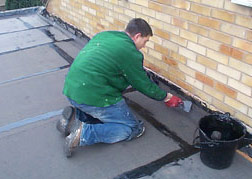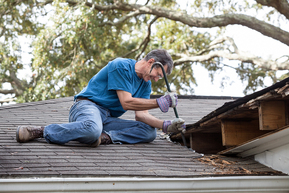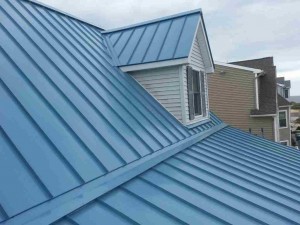
Flat roofs need more maintenance than pitched roofs because debris and water tend to collect or pool on the surface. A roof with less than 15 degrees of pitch is considered a flat roof. Flat roofs have normally long lifespan but only if proper maintenance is observed. Of course, the roof’s lifespan also depends on the kind of materials used.
The traditional felt-based roofs suffer from some shortcomings such as blistering, water ponding and splitting. Through regular maintenance, you can prevent damage to your flat roof and prolong its usable service life.
Here are practical flat roof solutions maintenance tips to ensure the durability of your home:
Blistering
Blister occurs when air is trapped between the felt substrate or layers of felt. Heat causes the air to expand, which pierces the felt when it breaks out. Blistering has more chances of occurring when the air bubble is large and occurs on a join. Water can now pass through the blisters and into the roof. We advise getting professional help to clean and fix the area to eliminate the blisters and make sure that waterproof condition is restored.
Ponding
Water ponding is one of the most common problems of flat roofs. This is indicated by standing pool of water on the roof’s surface or water mark around an area of the roof during dry conditions. You can use automatic water pump to collect water in the middle area of the roof or hoppers to collect the water near the edge. Ponding is easily remedied through regular maintenance to detect early signs of the problem.
Splitting
There are different causes of splitting such as pressure, stress, water ponding and freeze thawing. It could also be caused by poor workmanship quality. Foot traffic, walking on the surface or failure to maintain the reflective paint may be the culprits too. Large splits have to be repaired by professionals. Small splits or cracks may be fixed by the owner using commercially-available patch kits.
Proactive Maintenance
Performing regular maintenance with a proactive approach will prevent the occurrence of major problems that might necessitate costly roof repairs. If your roof was not built to be used as an outdoor roof deck, standing on it to clean debris and dirt may damage the material or slant of the roof, which allows water to run down. Using a leaf blower is an option to remove leaves and dirt on the roof. Better yet, engage the services of professionals to safely clean the roof.
Trees pose a problem too when they are allowed to grow high where their branches could scrape and damage the roof. Fallen leaves and branches could block gutters and downspouts as well.

Winter has run its course and is now giving way to spring. Hopefully, your roof protected you last winter and kept you warm and cozy through the cold months. We could all relax at home during winter and do our favorite activities—read books, watch videos and have those relaxing evening conversations after dinner—if we trust our roof to keep the harsh elements out of our home.
Now that spring is around the corner, it is time to show our appreciation to our roof by assessing how well it withstood the winter. Hopefully, it suffered no major problems that require immediate repair work. The best way to start checking your roof is by hiring the services of professional roofers to conduct an assessment for you. However, if you prefer to take the preliminary inspection, we outlined a guideline for roof maintenance that you can easily follow.
- Walk around the house at the ground and look at the gutters. Do they look somewhat out of place or sagging in some areas? Look for signs of water stains as these indicate overflowing, which in turn means that the gutter might be clogged. If so, check for debris and accumulation of dirt, leaves and other materials. Check the flashings too as they might have moved out of place.
- Regularly cleaning the gutter is always a good idea since dirt tends to accumulate through time and hinder the flow of water. Make sure the gutter is securely fastened to the eaves. Replace damaged areas if you noticed any holes or cracks to keep your gutter in tiptop condition.
- Note the condition of the roof. Are there are any sagging rooflines? Check for any loose or missing shingles that could have blown off the roof during winter. Debris on the roof is a starting area for water ponding and pooling of snow and ice. A visual inspection easily reveals the presence of moss and algae that are not only unsightly but could degrade your roof. A zinc strip can be installed and is effective against these infestations.
- Go up on the roof on a sunny day or when the weather is good. Observe all safety precautions in using ladders before going up. You can inspect the roof more closely up there and perform necessary repairs such as replacing missing or damaged shingles.
- Being up on the roof is the best time to check your chimneys and pipes. Pay close attention to the flashings and see if they are still securely fastened. Check the mortar on your chimney for any crumbling sign. A professional should do the work if you noticed problems on your chimney.
- While essential repairs may be done by homeowners with basic skills and knowledge on roofing, we recommend leaving major repairs to the professionals for your safety and quality of work.

The roof is an important part of your house. It protects you and your family from the elements. Severe weather conditions, however, could considerably shorten the lifespan of your roof. To keep it in excellent condition, you must perform regular checkup and maintenance. Taking care of your roof will ensure its long and healthy lifespan. Neglect to properly care for your roof could mean expensive repairs on your part.
Seattle is characterized by wet winters and dry summers. It receives more rainfall in November than any other cities in the US. It is, in fact, one of the five rainiest cities in the country. Seattle roofing maintenance presents a challenge if you have a home in the city. To help you care for your roofs and prolong their effective lifespan, we compiled these simple but effective tips.
- Regular Checkup. There is no harm in going up and checking your roof on a regular basis. You can also follow a schedule when to check on your roof. Most people examine their roofs in early spring for ice damming cause by the cold winter season and in late fall or just before the cold season to clear the roof of dirt that could block the passage of water.
- Fungus or Algae infestation. They may not substantially weaken the roof structure but the presence of these unwanted guests on the roof makes for an unsightly appearance of your house. Remove them using a combination of water and bleach. To prevent their recurrence, install zinc or copper metal strips on the roof.
- Evidence on the Ground. Broken pieces of roof materials, such as shingles, could fall to the floor. Look for these bits and pieces around the house, which indicates that your roof needs maintenance or repairs.
- Gutter Cleaning. Leaves and debris accumulate over time on the roof and gutters. They block the smooth flow of water from the roof to the downspout, which could potentially damage the gutters and lead to costly repairs. Check for these objects in late fall when trees shed their leaves.
- Trim the Trees. Trim excess tree limbs that touch the roof. Overhanging branches could damage your roof when they are forcefully blown by winds or scrape the protective coating of the roofing material. They also pose a danger to unsuspecting occupants of the house should they fall.
- Check the Flashing. Remember to check the condition of flashing around vents, chimneys and exhaust pipes. Punctured or bent flashing is a common cause of leaks, as well as a dried-out sealant. Since flashing covers a hole in your roof, it is important that it is always in tiptop condition.


